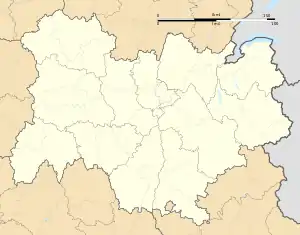Gouffre Mirolda
Gouffre Mirolda is a karstic cave located in the Haut-Giffre[1] mountain range, in the commune of Samoëns, Haute-Savoie, France. It is connected to the Lucien Bouclier cave network, and has a depth of −1,733 m (−5,686 ft).[2]
| Gouffre Mirolda | |
|---|---|
 Location  Gouffre Mirolda (Auvergne-Rhône-Alpes) | |
| Location | Samoëns, France |
| Coordinates | 46°05′19.9″N 6°46′14″E |
| Depth | 1,733 metres (5,686 ft) |
| Length | 17,920 metres (58,790 ft) |
| Elevation | 1,880 metres (6,170 ft) |
| Discovery | 1971 |
| Entrances | 7 |
.jpg.webp)
Exploration
The cave was discovered in 1971 by Marc Degrinis[2], a shepherd .In 1972, the AVEN group in Lyon widened the entrance crack and stopped at −127 m (−417 ft) on an impenetrable meander. In 1976, an upper entrance, the VF3, at 2,324 m (7,625 ft), was discovered by the Villefranche caving club (EESV) with a stop at the bottom of the first 30 m (98 ft) shaft on a narrow slope. The Gouffre Mirolda (CD11) was redesigned in 1980 by SC Lyon. With the help of the GS Cavernicole and the SC du Chablais, the −850 m (−2,790 ft) elevation was reached. In 1981, the river was explored down to −1,100 m (−3,600 ft). Reinforced by the SS Genève and the Thonon Tauping Club, fossil galleries and upstream tunnels enabled the network to reach a height difference of 1,143 m (3,750 ft) in 1988. The unblocking of the Gouffre VF3 gives access to the network named after Lucien Bouclier, a speleologist who died in 1987 on the massif. The junction was made by the Ursus group between the gouffre Mirolda and the réseau Lucien Bouclier in 1992 for a depth of −1,436 m (−4,711 ft) and with the gouffre de la Rondelle Jaune (2,220 m (7,280 ft)). At the bottom of CD11 the elevation rose in 1993 to −1,520 m (−4,990 ft) and −1,610 m (−5,280 ft) in 1998.[3] The Gouffre du Joker (2,332 m (7,651 ft)) joined the network in 1999 and increased the rating to −1,616 m (−5,302 ft). After the dive of the terminal sump in 2003, this chasm has a depth of −1,733 m (−5,686 ft), finally explored. The cave was measured to be −1,733 m (−5,686 ft) deep, making it the deepest natural cave in the world from January 2003 until July 2004,[4][5] when it was passed by the cave Krubera-Voronja in Abkhazia.[6] In September 2022 and 2023 a Collectif Mirolda takes over the topography, modernizes the equipment and examines the possibilities of discovery.[7] It is the deepest cave in France. The cave's name is derived from the forenames of the Rhodanien cavers Michel Schmidt, Roland Chenevier, and Daniel Trouilleux, who were lost in a flood in Gournier Cave in November 1976.[8]
Description
The highest entrance to the cave is at 2332 meters. The lowest point of the cave is at −1,733 m (−5,686 ft) at the grand siphon in the gallery.[9] The bottom of the gallery (after the second siphon) has only been explored once, leaving room for further exploration. Behind the second siphon (approximately −1,620 m (−5,310 ft)) the gallery continues for 22 m (72 ft) horizontally and down 8 meters, leading to an ancient drainage system. Downstream, the gallery descends over a length of 251 meters and a vertical drop of 110 meters before coming up against the first siphon at −1,733 m (−5,686 ft). Past the siphon the gallery splits in two, the left leading up towards the ceiling and the right leading 50 meters to the fossil gallery.[10]
Karst Development
The Gouffre Mirolda is located in the Urgonian Limestone at the contact of the Hauterivian marl following the dip (E-W) then (S-W) towards the Giffre valley. The water flows into the alluvable aquifer and no resurgence is known.[1][3] As at the Gouffre Jean-Bernard, the upstream of the réseau Lucien Bouclier seems older and the bottom of the CD 11 dug following the incision of the Giffre valley.[11]
References
- Delannoy, Jean-Jacques; Maire, Richard (1984). "Les grandes cavités alpines. Répartition et contexte hydrogéologique" [Large alpine cavities. Distribution and hydrogeological context]. karstologia (in French). Fédération française de spéléologie and Association française de karstologie. p. 61..
- "Complément d'information sur le nouveau record du monde de profondeur de spéléologie (january 2003)". Retrieved 2023-10-20.
- Clubs Cavernicoles and Ursus (April 1998). "-1610 m au gouffre Mirolda" (PDF). Spelunca (in French). No. 69. Fédération française de spéléologie. pp. 25–40. ISSN 0249-0544. Retrieved 2023-10-20.
- de Sainte Lorette, Cedran (28 July 2015). "Quand Mirolda devint le gouffre le plus profond du monde". Le Dauphiné Libéré (in French).
- Courbon, Paul (2007). "Échos des profondeurs" (PDF). chroniques-souterraines.fr (in French).
- Courbon, Paul (2019). "Le gouffre le plus profond du monde" (PDF). Spelunca (in French). Fédération française de spéléologie. 155: 26–31. ISSN 0249-0544. Retrieved 2023-10-21.
- "Les topographies du système du Criou" (in French). Retrieved 2023-09-14.
- "Deux spéléologues lyonnais meurent noyés". lemonde.fr/archives (in French). 11 November 1976.
- Drouin, Philippe (September 2007), "Gouffres les plus profonds du monde" (PDF), Spelunca (in French), French Federation of Speleology, 108: 4
- Colliard, Daniel (2003), "Nouveau record du monde au réseau Mirolda - Lucien Bouclier (Massif du Criou - Samoëns - Haute-Savoie) –1733 m" (PDF), Spelunca (in French), French Federation of Speleology, 89: 5–6
- Comité départemental de spéléologie de Haute-Savoie (2022). Grottes et gouffres de Haute-Savoie (in French). pp. 173–179.